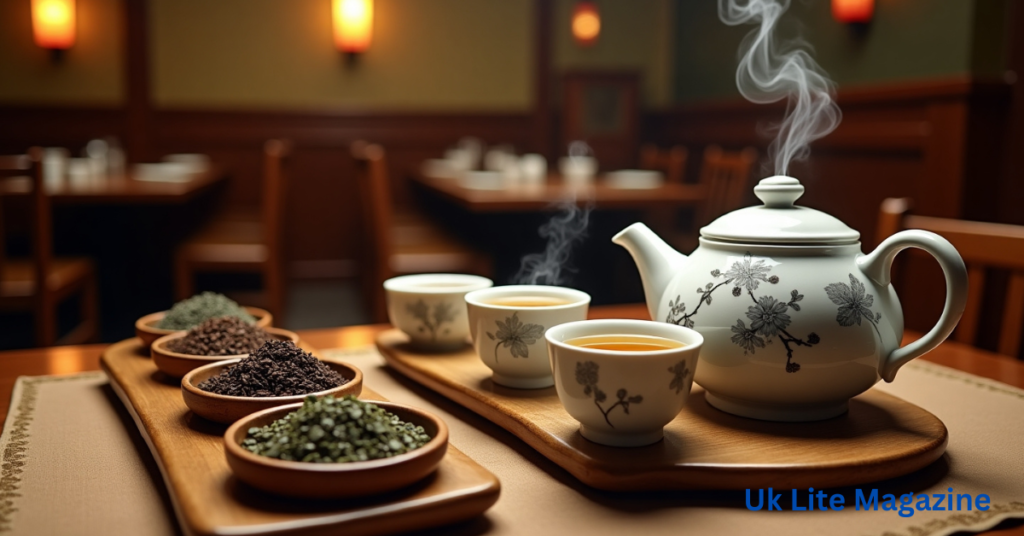Tea is an essential part of Chinese culture, deeply rooted in tradition and often served in restaurants as a complementary drink. Many diners wonder: What is the tea used in Chinese restaurants? This article explores the most common types of tea served, their benefits, and why they are chosen to accompany Chinese cuisine.
Common Types of Tea Used in Chinese Restaurants
1. Jasmine Tea
Jasmine tea is one of the most popular teas served in Chinese restaurants. It is made by blending green tea leaves with jasmine flowers, creating a fragrant and refreshing beverage.
Why is it served?
- The floral aroma enhances the dining experience.
- It complements a wide range of Chinese dishes, especially seafood and dim sum.
2. Oolong Tea
Oolong tea is a semi-fermented tea that falls between green and black tea in terms of oxidation. It has a rich, complex flavor that can be floral, toasty, or slightly sweet.
Why is it served?
- It helps with digestion, making it a great choice for heavy meals.
- The bold flavor pairs well with fried and spicy foods.
3. Pu-erh Tea
Pu-erh tea is a fermented tea known for its deep, earthy flavor. It is often aged for several years, enhancing its taste and health benefits.
Why is it served?
- It aids digestion and reduces fat absorption, making it ideal for rich, oily dishes.
- It is believed to have detoxifying properties.
4. Chrysanthemum Tea
Unlike other teas, chrysanthemum tea is a caffeine-free herbal infusion made from dried chrysanthemum flowers. It has a mild, floral taste with natural sweetness.
Why is it served?
- It helps cool the body and is often enjoyed in hot weather.
- It has soothing properties, making it a relaxing post-meal drink.
5. Green Tea
Green tea is widely consumed in China and is often served in restaurants, especially in its loose-leaf form.
Why is it served?
- It is rich in antioxidants and promotes overall health.
- The fresh and slightly bitter taste balances the richness of Chinese dishes.
Health Benefits of Chinese Restaurant Teas
Each type of tea offers unique health benefits. Here’s a comparative table for better understanding:
| Tea Type | Key Benefits | Best Paired With |
|---|---|---|
| Jasmine Tea | Boosts relaxation, supports digestion | Dim sum, seafood |
| Oolong Tea | Aids digestion, improves metabolism | Fried and spicy foods |
| Pu-erh Tea | Helps with fat breakdown, detoxifying effects | Heavy, oily dishes |
| Chrysanthemum Tea | Reduces body heat, calms nerves | Light meals, summer dishes |
| Green Tea | High in antioxidants, supports heart health | Rice-based dishes, stir-fries |
Why Do Chinese Restaurants Serve Tea?
Chinese restaurants serve tea for multiple reasons:
- Tradition & Culture – Tea drinking is a fundamental aspect of Chinese hospitality.
- Enhancing the Meal Experience – Tea cleanses the palate and enhances the flavors of the food.
- Digestive Benefits – Many teas help break down oils and aid digestion, making meals more enjoyable.
- Relaxation & Comfort – Tea has calming effects, making it a great companion to a dining experience.
How to Brew Tea Like in Chinese Restaurants?
If you want to enjoy Chinese restaurant-style tea at home, follow these steps:
- Use Loose-Leaf Tea – Loose leaves provide better flavor than tea bags.
- Use Hot (Not Boiling) Water – Different teas require different temperatures (e.g., green tea should not be steeped in boiling water).
- Steep for the Right Time – Over-steeping can result in bitterness.
- Use a Teapot or Gaiwan – Traditional brewing methods enhance the taste.
- Enjoy Without Sugar – Authentic Chinese tea is usually served plain to appreciate its natural flavors.
Conclusion
Tea plays an essential role in Chinese restaurants, offering a perfect balance of flavor and health benefits. Whether it’s the fragrant Jasmine Tea, the rich Oolong Tea, or the digestive-friendly Pu-erh Tea, each variety has a unique purpose. The next time you enjoy a meal at a Chinese restaurant, take a moment to appreciate the tea served—it’s more than just a drink; it’s a cultural experience.
Frequently Asked Questions (FAQs)
1. Why do Chinese restaurants serve free tea?
Many Chinese restaurants offer tea as a gesture of hospitality. It also helps with digestion and enhances the dining experience.
2. Can I request a specific type of tea in a Chinese restaurant?
Yes, many restaurants have different teas available upon request, though Jasmine and Oolong teas are the most commonly served by default.
3. Is Chinese restaurant tea caffeinated?
Most Chinese restaurant teas, like Jasmine, Oolong, and Pu-erh, contain caffeine, while herbal teas like Chrysanthemum are caffeine-free.
4. How can I buy tea similar to what is served in Chinese restaurants?
You can find these teas in Asian grocery stores, online retailers, or specialty tea shops. Look for loose-leaf varieties for the best quality.
5. Can I add sugar or milk to Chinese restaurant tea?
Traditionally, Chinese tea is enjoyed plain to preserve its natural taste and health benefits. However, personal preferences vary.

